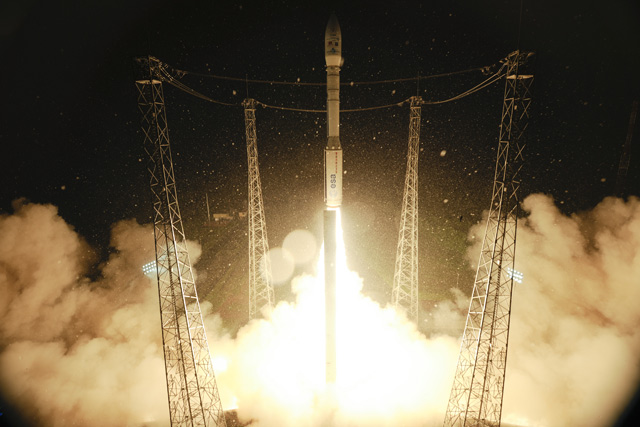As the European Space Agency makes final preparations for the third flight of its new Vega light launcher, unrest in Ukraine will be about as far from its operators’ minds as Kourou is from Kiev – but once VV03 is complete on Monday 28 April, programme officials will continue their watch on the tense situation in a country that supplies a critical component of what is otherwise a Western Europe-built vehicle.
Speaking to Flightglobal from Paris as he prepared to board a flight for ESA’s French Guiana launch site, Vega programme manager Stefano Bianchi stressed that, so far, there has been no indication from either Ukraine or Russia of any threat to supply of the RD-869 restartable rocket motor, which forms the fourth-stage propulsion unit that carries Vega’s payloads to their final orbit. The RD-869 is built by Yuzhnoye in Dnipropetrovsk, just east of the Dnieper river that runs north-south through the country to the Black Sea.
Bianchi says he will remain in regular contact with ESA’s contact in the region to keep tabs on the situation. But, for now, ESA has “firm orders” for five of the rocket motors (which are joined to an avionics unit to make up the final stage by Avio in Italy) and 10 tank sets – and no cause to believe they won’t be delivered.
That supply would get ESA through its next launch, scheduled for October or November this year to fly its IXV re-entry vehicle test bed, and the three launches scheduled for 2015. ESA also has 10 more Vega launchers on order, he adds.
But ESA, he says, also has a longstanding “plan B” to “Europeanise” Vega by developing a home-grown upper stage rocket motor. If the worst-case scenario were to play out and Dnipropetrovsk were unable to continue supplying Vega, nothing could happen fast. However, says Bianchi, if the situation becomes urgent, ESA would have to respond by accelerating its efforts to provide an alternative.
Vega made its first flight in February 2012. Its 1,500kg payload capacity makes it ideal for lifting scientific and Earth observation satellites into polar orbits. VV03's payload is the Airbus Defence & Space-built KazEOSat-1 high-resolution Earth observation satellite, for Kazakhstan. The rocket sits below ESA’s medium-lift Soyuz and heavy Ariane 5 rockets, which also fly from its launch centre at Kourou, French Guiana.


ESA
Vega is also a key element in the plan to replace Ariane 5 with an all-solid fuel, modular Ariane 6 from about 2021. Ariane 6’s strap-on boosters will be, essentially, Vega stages.
As much of the motivation behind developing Vega was to enhance Europe's independent capability to access space, there has been some discomfort at relying on an import for such a key component as the restartable, liquid-fuel upper stage, which is needed to put multiple payloads into different orbits. That restart capability also helps Vega fulfil an important mission objective – to de-orbit the final stage rather than have it add to the growing problem of orbiting debris.
The RD-869, however, is a tried-and-tested motor, also used as the third stage on the Dnepr launch vehicle and its predecessor, the SS-18 (SATAN) intercontinental ballistic missile.
While France has historically taken the lead on European rocket development, Vega’s champion has for a decade been the Italian space agency, ASI. Germany’s aerospace technology agency, DLR, is understood to be keen to work with the Italians to develop a replacement for the RD-869.
Whether current events in Ukraine change ESA’s mind about the urgency of new upper stage remains to be seen. But at the time of Vega’s first flight, two years ago, Bianchi stressed the need keep a sharp focus on programme costs, which are hoped to come down with experience to a highly competitive €35 million ($48 million). That price is about half the €64 million cost of a Soyuz launch from Kourou, suitable for larger or multiple satellites or deep space missions. Ariane 5, capable of hefting the biggest telecoms satellites to the highest, geosynchronous orbits and also lined up to launch the James Webb space telescope to deep space in 2018, can cost as much as €200 million per launch.
Said Bianchi back in 2012 on the eve of Vega’s maiden flight, the cost equation will demand no change to Vega hardware for 10 years or more than 20 launches: "You need to consolidate or you can't be competitive. You can't keep changing."
Source: FlightGlobal.com



















